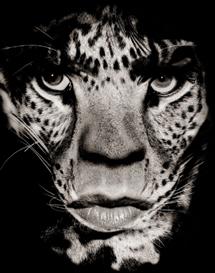Master Interview: Albert Watson; The Discerning Eye
Albert Watson's powerful vision bridges the worlds of darkroom and digital.
With more than 250 Vogue covers to his credit, three award-winning books, more
than 650 commercials and music videos, he is a reigning master of both stunning
black and white and cutting-edge color. His advertising clients include Chanel,
Levi's, Gap, and Revlon, and his editorial work ranges from Rolling Stone
to Time. While many of his clients aim at a decidedly young market, Watson is
their first choice photographer, even though, at 65, he is at an age where many
retire. And there's another conundrum--although he has embraced digital
inkjet technology for large format color and black and white printing for his
international gallery and museum exhibitions, he prefers to shoot film. Furthermore,
alongside the HP inkjet printers, the studio of this master printer continues
to work with silver halide papers as well as alternative processes. Recently,
one of his toned black and white portraits of the model Kate Moss sold for $106,000
at auction in London.
I recently spoke with Watson about his approach to our medium, his shooting,
lighting, and printing techniques.
 |
|
|
Shutterbug: What can a photograph do and what can't
it do? Some say that a photograph can reveal the subject's personality.
Albert Watson: Today, photography has an instant recognizability
that everyone can understand. The communication is instant. It's not so
complex. Photography can do a lot of things--it can distort, it can give
you correct information or false information. Now of course, photos can be easily
manipulated.
Sometimes, a good photo can reveal the inner self. The American Indians felt
that a photograph was stealing their soul, taking something from them that they
didn't get back. A photo can do a lot, but it can't necessarily
do everything. You can really play with emotions in a photograph, you can reveal
inner personas, and you can manipulate if you're clever. The photographer
is part magician, he can do wondrous things with lighting, he can alter things
and make things stranger and weirder, and more appealing or even less appealing.
The photographer can be the master of his own destiny.
 |
SB: Did you start out shooting in black and white?
AW: In school in Scotland [where he was born], I studied graphic
design, then film and television in London. It was important that you learn
to print in a darkroom. Fine art photography back then emphasized black and
white. One reason is that since we see in color, black and white is a bit surreal.
I was fascinated by the fact that you put a piece of white paper into some liquid
and up came an image. There was what you shot the day before. It was a magical
process. I loved the printing process and I do to this day. Now it has expanded
beyond silver printing to platinum/palladium and digital. I've never lost
the desire to be hands-on and actually make the image myself. We're not
sending anything out (to an outside lab). We make all prints in my studio. At
the beginning of the digital revolution, we sent stuff out, but it only lasted
about six months. For me it was a disaster, the difficulty of communicating
what I wanted to the printer. We brought the digital printing into our own studio
very quickly.
 |
SB: How did you choose HP over other models?
AW: HP approached us and said they were interested in gallery
and museum shows. First came an aesthetic, creative decision to try digital.
Then once we tried it, we worked with it until we mastered it.
I began with the HP Z3100, and it wasn't all rosy at first, there were
some problems. We had to make some adjustments toward the printer. But in the
end, that piece of machinery was damned impressive. Photographers are looking
for two things--consistency and a heavy-duty workhorse. We want something
that doesn't require someone to come in and tweak it, and then two weeks
later need to come back again.
 |
SB: You have several shows in Europe right now. Are those
digital or silver or both?
AW: We have some early prints in the shows that are silver,
mounted on board. Then there's a second generation of silver and platinum
prints that are mounted on aluminum, a better substrate. The shows also contain
C-prints printed through a digital LightJet system from a scanned negative or
transparency. Now with the HP printers, we have 12 pigment inks for archival
stability, and we can make very large format prints.
SB: Your books, Cyclops and Maroc (Morocco) contain several
different alternative process prints with dramatic visible brush strokes.
AW: We did platinum on ancient papers, 200 years old, and even
on goat skins, and we did cyanotypes, appropriate to images of such an ancient
kingdom. The cover of Maroc was originally a cyanotype on Arches paper that
I then worked on with some colored inks, smudging them on with my fingertips.
I made perhaps 10 cyanotypes of this image then added different inks to them
before arriving at the final image.
 |
SB: Your portrait of Waris also emphasizes the brush strokes
of a hand-coated platinum print, and I see that you did hand work, kind of scribbling,
within the hair. You spoke of scanned negatives. Are you shooting digitally
at all?
AW: Some 99.999 percent of my shooting is film. When I'm
working on 4x5 cameras and 8x10, I've been a photographer so long that
I know when I have the shot. So I don't quite see the point of digital
for me. Of course I know why someone would do it. But, for me, film is more
beautiful. If you take a scan of 8x10 film and put it beside the file from the
biggest file you could possibly make from a digital back camera, the 8x10 film
scan is more beautiful, more charismatic.
- Log in or register to post comments

















































